Lubomir Bourdev
PIM: Video Coding using Perceptual Importance Maps
Dec 20, 2022Abstract:Human perception is at the core of lossy video compression, with numerous approaches developed for perceptual quality assessment and improvement over the past two decades. In the determination of perceptual quality, different spatio-temporal regions of the video differ in their relative importance to the human viewer. However, since it is challenging to infer or even collect such fine-grained information, it is often not used during compression beyond low-level heuristics. We present a framework which facilitates research into fine-grained subjective importance in compressed videos, which we then utilize to improve the rate-distortion performance of an existing video codec (x264). The contributions of this work are threefold: (1) we introduce a web-tool which allows scalable collection of fine-grained perceptual importance, by having users interactively paint spatio-temporal maps over encoded videos; (2) we use this tool to collect a dataset with 178 videos with a total of 14443 frames of human annotated spatio-temporal importance maps over the videos; and (3) we use our curated dataset to train a lightweight machine learning model which can predict these spatio-temporal importance regions. We demonstrate via a subjective study that encoding the videos in our dataset while taking into account the importance maps leads to higher perceptual quality at the same bitrate, with the videos encoded with importance maps preferred $2.1 \times$ over the baseline videos. Similarly, we show that for the 18 videos in test set, the importance maps predicted by our model lead to higher perceptual quality videos, $2 \times$ preferred over the baseline at the same bitrate.
An Interactive Annotation Tool for Perceptual Video Compression
May 08, 2022
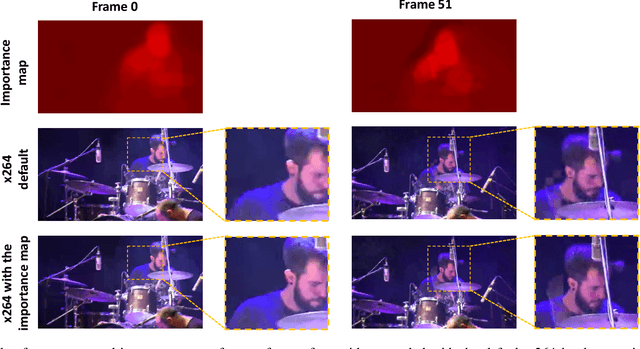
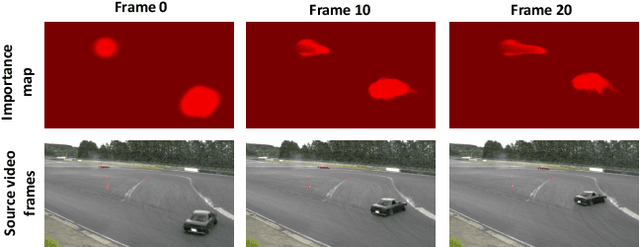
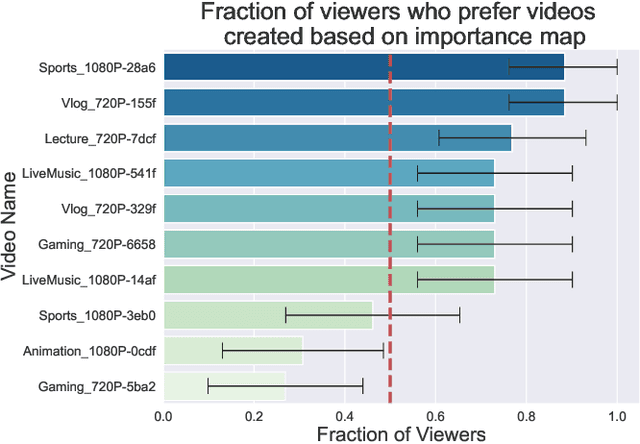
Abstract:Human perception is at the core of lossy video compression and yet, it is challenging to collect data that is sufficiently dense to drive compression. In perceptual quality assessment, human feedback is typically collected as a single scalar quality score indicating preference of one distorted video over another. In reality, some videos may be better in some parts but not in others. We propose an approach to collecting finer-grained feedback by asking users to use an interactive tool to directly optimize for perceptual quality given a fixed bitrate. To this end, we built a novel web-tool which allows users to paint these spatio-temporal importance maps over videos. The tool allows for interactive successive refinement: we iteratively re-encode the original video according to the painted importance maps, while maintaining the same bitrate, thus allowing the user to visually see the trade-off of assigning higher importance to one spatio-temporal part of the video at the cost of others. We use this tool to collect data in-the-wild (10 videos, 17 users) and utilize the obtained importance maps in the context of x264 coding to demonstrate that the tool can indeed be used to generate videos which, at the same bitrate, look perceptually better through a subjective study - and are 1.9 times more likely to be preferred by viewers. The code for the tool and dataset can be found at https://github.com/jenyap/video-annotation-tool.git
ELF-VC: Efficient Learned Flexible-Rate Video Coding
Apr 29, 2021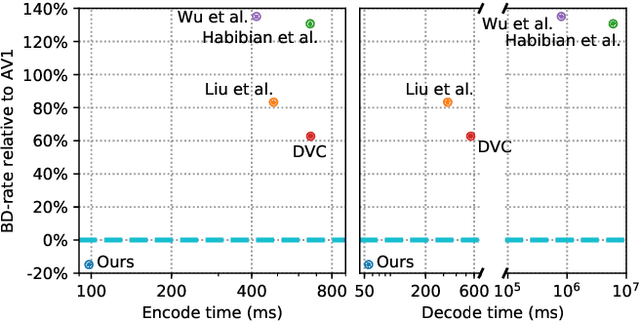

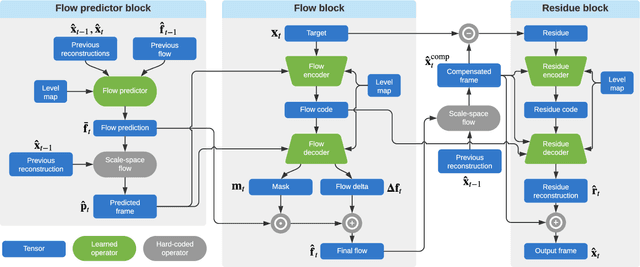

Abstract:While learned video codecs have demonstrated great promise, they have yet to achieve sufficient efficiency for practical deployment. In this work, we propose several novel ideas for learned video compression which allow for improved performance for the low-latency mode (I- and P-frames only) along with a considerable increase in computational efficiency. In this setting, for natural videos our approach compares favorably across the entire R-D curve under metrics PSNR, MS-SSIM and VMAF against all mainstream video standards (H.264, H.265, AV1) and all ML codecs. At the same time, our approach runs at least 5x faster and has fewer parameters than all ML codecs which report these figures. Our contributions include a flexible-rate framework allowing a single model to cover a large and dense range of bitrates, at a negligible increase in computation and parameter count; an efficient backbone optimized for ML-based codecs; and a novel in-loop flow prediction scheme which leverages prior information towards more efficient compression. We benchmark our method, which we call ELF-VC (Efficient, Learned and Flexible Video Coding) on popular video test sets UVG and MCL-JCV under metrics PSNR, MS-SSIM and VMAF. For example, on UVG under PSNR, it reduces the BD-rate by 44% against H.264, 26% against H.265, 15% against AV1, and 35% against the current best ML codec. At the same time, on an NVIDIA Titan V GPU our approach encodes/decodes VGA at 49/91 FPS, HD 720 at 19/35 FPS, and HD 1080 at 10/18 FPS.
Learned Video Compression
Nov 16, 2018



Abstract:We present a new algorithm for video coding, learned end-to-end for the low-latency mode. In this setting, our approach outperforms all existing video codecs across nearly the entire bitrate range. To our knowledge, this is the first ML-based method to do so. We evaluate our approach on standard video compression test sets of varying resolutions, and benchmark against all mainstream commercial codecs, in the low-latency mode. On standard-definition videos, relative to our algorithm, HEVC/H.265, AVC/H.264 and VP9 typically produce codes up to 60% larger. On high-definition 1080p videos, H.265 and VP9 typically produce codes up to 20% larger, and H.264 up to 35% larger. Furthermore, our approach does not suffer from blocking artifacts and pixelation, and thus produces videos that are more visually pleasing. We propose two main contributions. The first is a novel architecture for video compression, which (1) generalizes motion estimation to perform any learned compensation beyond simple translations, (2) rather than strictly relying on previously transmitted reference frames, maintains a state of arbitrary information learned by the model, and (3) enables jointly compressing all transmitted signals (such as optical flow and residual). Secondly, we present a framework for ML-based spatial rate control: namely, a mechanism for assigning variable bitrates across space for each frame. This is a critical component for video coding, which to our knowledge had not been developed within a machine learning setting.
Real-Time Adaptive Image Compression
May 16, 2017



Abstract:We present a machine learning-based approach to lossy image compression which outperforms all existing codecs, while running in real-time. Our algorithm typically produces files 2.5 times smaller than JPEG and JPEG 2000, 2 times smaller than WebP, and 1.7 times smaller than BPG on datasets of generic images across all quality levels. At the same time, our codec is designed to be lightweight and deployable: for example, it can encode or decode the Kodak dataset in around 10ms per image on GPU. Our architecture is an autoencoder featuring pyramidal analysis, an adaptive coding module, and regularization of the expected codelength. We also supplement our approach with adversarial training specialized towards use in a compression setting: this enables us to produce visually pleasing reconstructions for very low bitrates.
ProNet: Learning to Propose Object-specific Boxes for Cascaded Neural Networks
Apr 13, 2016



Abstract:This paper aims to classify and locate objects accurately and efficiently, without using bounding box annotations. It is challenging as objects in the wild could appear at arbitrary locations and in different scales. In this paper, we propose a novel classification architecture ProNet based on convolutional neural networks. It uses computationally efficient neural networks to propose image regions that are likely to contain objects, and applies more powerful but slower networks on the proposed regions. The basic building block is a multi-scale fully-convolutional network which assigns object confidence scores to boxes at different locations and scales. We show that such networks can be trained effectively using image-level annotations, and can be connected into cascades or trees for efficient object classification. ProNet outperforms previous state-of-the-art significantly on PASCAL VOC 2012 and MS COCO datasets for object classification and point-based localization.
Metric Learning with Adaptive Density Discrimination
Mar 02, 2016



Abstract:Distance metric learning (DML) approaches learn a transformation to a representation space where distance is in correspondence with a predefined notion of similarity. While such models offer a number of compelling benefits, it has been difficult for these to compete with modern classification algorithms in performance and even in feature extraction. In this work, we propose a novel approach explicitly designed to address a number of subtle yet important issues which have stymied earlier DML algorithms. It maintains an explicit model of the distributions of the different classes in representation space. It then employs this knowledge to adaptively assess similarity, and achieve local discrimination by penalizing class distribution overlap. We demonstrate the effectiveness of this idea on several tasks. Our approach achieves state-of-the-art classification results on a number of fine-grained visual recognition datasets, surpassing the standard softmax classifier and outperforming triplet loss by a relative margin of 30-40%. In terms of computational performance, it alleviates training inefficiencies in the traditional triplet loss, reaching the same error in 5-30 times fewer iterations. Beyond classification, we further validate the saliency of the learnt representations via their attribute concentration and hierarchy recovery properties, achieving 10-25% relative gains on the softmax classifier and 25-50% on triplet loss in these tasks.
Deep End2End Voxel2Voxel Prediction
Nov 20, 2015



Abstract:Over the last few years deep learning methods have emerged as one of the most prominent approaches for video analysis. However, so far their most successful applications have been in the area of video classification and detection, i.e., problems involving the prediction of a single class label or a handful of output variables per video. Furthermore, while deep networks are commonly recognized as the best models to use in these domains, there is a widespread perception that in order to yield successful results they often require time-consuming architecture search, manual tweaking of parameters and computationally intensive pre-processing or post-processing methods. In this paper we challenge these views by presenting a deep 3D convolutional architecture trained end to end to perform voxel-level prediction, i.e., to output a variable at every voxel of the video. Most importantly, we show that the same exact architecture can be used to achieve competitive results on three widely different voxel-prediction tasks: video semantic segmentation, optical flow estimation, and video coloring. The three networks learned on these problems are trained from raw video without any form of preprocessing and their outputs do not require post-processing to achieve outstanding performance. Thus, they offer an efficient alternative to traditional and much more computationally expensive methods in these video domains.
Learning Spatiotemporal Features with 3D Convolutional Networks
Oct 07, 2015



Abstract:We propose a simple, yet effective approach for spatiotemporal feature learning using deep 3-dimensional convolutional networks (3D ConvNets) trained on a large scale supervised video dataset. Our findings are three-fold: 1) 3D ConvNets are more suitable for spatiotemporal feature learning compared to 2D ConvNets; 2) A homogeneous architecture with small 3x3x3 convolution kernels in all layers is among the best performing architectures for 3D ConvNets; and 3) Our learned features, namely C3D (Convolutional 3D), with a simple linear classifier outperform state-of-the-art methods on 4 different benchmarks and are comparable with current best methods on the other 2 benchmarks. In addition, the features are compact: achieving 52.8% accuracy on UCF101 dataset with only 10 dimensions and also very efficient to compute due to the fast inference of ConvNets. Finally, they are conceptually very simple and easy to train and use.
Improving Image Classification with Location Context
May 14, 2015



Abstract:With the widespread availability of cellphones and cameras that have GPS capabilities, it is common for images being uploaded to the Internet today to have GPS coordinates associated with them. In addition to research that tries to predict GPS coordinates from visual features, this also opens up the door to problems that are conditioned on the availability of GPS coordinates. In this work, we tackle the problem of performing image classification with location context, in which we are given the GPS coordinates for images in both the train and test phases. We explore different ways of encoding and extracting features from the GPS coordinates, and show how to naturally incorporate these features into a Convolutional Neural Network (CNN), the current state-of-the-art for most image classification and recognition problems. We also show how it is possible to simultaneously learn the optimal pooling radii for a subset of our features within the CNN framework. To evaluate our model and to help promote research in this area, we identify a set of location-sensitive concepts and annotate a subset of the Yahoo Flickr Creative Commons 100M dataset that has GPS coordinates with these concepts, which we make publicly available. By leveraging location context, we are able to achieve almost a 7% gain in mean average precision.
 Add to Chrome
Add to Chrome Add to Firefox
Add to Firefox Add to Edge
Add to Edge